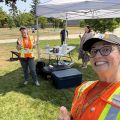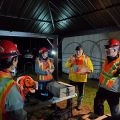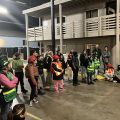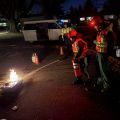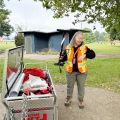Portland Preparedness Data Almanac: Difference between revisions
| Line 30: | Line 30: | ||
==== 2024 Dollar Inputs ==== | ==== 2024 Dollar Inputs ==== | ||
These figures do not include staff expenses; only external goods, services, and invoices. See the Budget Dashboard for a full breakdown of spending by category. | These figures do not include staff expenses; only external goods, services, and invoices. See the [https://app.smartsheet.com/b/publish?EQBCT=339d2fe9fca64aa88a59397af11c079f Budget Dashboard] for a full breakdown of spending by category. | ||
{| class="wikitable" | {| class="wikitable" | ||
|+ | |+ | ||
Revision as of 13:27, 1 February 2025
This data almanac is established to make available and accessible all salient Community Preparedness data collected by PBEM, sectioned into calendar years. PBEM does not make raw data downloadable because raw data includes Personally Identifiable Information (PII). However, where possible, PBEM breaks datasets into Portland Districts and neighborhoods to allow community leaders in those areas to make informed and data-driven decisions about emergency planning and disaster response strategies.
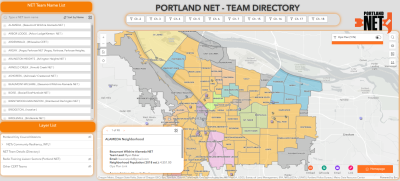
The almanac is a data storehouse for point in time data. The almanac does not include year to year comparisons or dynamic data, which may be found on the dashboards or maps below:
| Dashboard or Map |
|---|
| Portland NET Team Directory |
| BEECN Status Dashboard |
| Community Preparedness Budget Dashboard |
| PBEM Annual Volunteer Customer Service Survey Results |
| PBEM Community Outreach Tracking |
2024 PBEM Community Preparedness Program Data
2024 Program Inputs
2024 Dollar Inputs
These figures do not include staff expenses; only external goods, services, and invoices. See the Budget Dashboard for a full breakdown of spending by category.
| Dollar
Inputs |
City general fund | $40,703 |
| Grants | $81,658 | |
| TOTAL | $122,361 |
2024 Community Preparedness Team at PBEM
| Staff Name | FTE | Responsibilities | 2024 in position |
|---|---|---|---|
| Devitt, Glenn | 1.0 | Neighborhood Emergency Teams (NET) | 2024.01.01 - 2024.12.31 |
| Ingabire, Regina | 1.0 | Community Organizations Active in Disaster (COAD), Community-based organization (CBO) partnerships | 2024.01.01 - 2024.12.31 |
| Jones, Ernie | 1.0 | BEECN and amateur radio programming (retired in January 2024) | 2024.01.01 - 2024.01.24 |
| Lozano-Peralta, Marisol | 0.5 | Unidos Contra Desastres | 2024.02.12 - 2024.12.31 |
| Van Keuren, Jeremy | 1.0 | Program supervision, BEECN | 2024.01.01 - 2024.12.31 |
| Estimated team hours [1] | 7,424 | ||
2024 General Data
| Total volunteer hours [2] | Q1 | Q2 | Q3 | Q4 | YEAR TOTAL |
| 5,675 | 7,865 | 4,353 | 7,159 | 25,053 | |
| Deployment/Program Service hours [3] | 2,743 (11%) | ||||
| Basic NET Training hours [4] | 5,142 (21%) | ||||
| Advanced NET/Exercise hours [5] | 6,476 (26%) | ||||
| BEECN/Amateur Radio hours [6] | 4,943 (20%) | ||||
| Community Engagement hours [7] | 5,747 (23%) | ||||
| Pareto number [8] | 12.17% | 15.61% | 8.48% | 13.71% | 25.32% |
| Volunteer hours value | $810,933 | ||||
2024 Significant Events
 |
There is an expanding table here! Click "Expand" to see the data. |
2024 Community Based Organizations (CBO) Partnerships
| Start Date | CBO | Description/Notes |
|---|---|---|
| 2024.10.05 | Rosewood Initiative | Disaster preparedness series, seven classes delivered in Spanish from 10/05 - 11/23;
12 First Aid certifications, 14 AED/CPR certifications, 15 Stop the Bleed certifications |
| 2024.05.22 | Native American Youth and Family Center (NAYA) | CPR/AED/First Aid certification for NAYA staff, 17 certifications (five are CPR/AED only) |
| 2024.05.21 | Native American Youth and Family Center (NAYA) | CPR/AED/First Aid certification for NAYA staff, 14 certifications (one is CPR/AED only) |
| 2024.05.17 | REAP | CPR/AED/First Aid certification for REAP staff, 14 certifications (two are CPR/AED only) |
| 2024.05.13 | REAP | CPR/AED/First Aid certification for REAP staff, 14 certifications |
| 2024.05.03 | Native American Youth and Family Center (NAYA) | Pediatric CPR/AED/First Aid certification for NAYA staff, 10 certifications, UASI funded |
| 2024.04.19 | Immigrant and Refugee Community Organization (IRCO) | CPR/AED/First Aid certification for IRCO staff, 15 certifications, UASI funded |
| 2024.04.18 | Immigrant and Refugee Community Organization (IRCO) | CPR/AED certification class for IRCO staff, 12 certifications, UASI funded |
| 2024.01.31 | Latino Network | First Aid certification class, 16 certifications |
2024 Volunteer Program Activity Data
Numbers reflect point in time at the end of 2024.
| Volunteer Deployments | |
|---|---|
| Deployment events | 10 |
| Estimated deployment hours | |
| Basic NET Training | |
|---|---|
| Basic NET classes | 3 |
| Graduates | 176 |
| Basic BEECN Training | |
|---|---|
| Basic BEECN classes | 11 |
| Completed training | 307 |
| New BEECN volunteers | |
| Advanced Training/Exercises | |
|---|---|
| Advanced training events | 85 |
| Seats | 2,149 |
| In person seats / Online class seats | 1,236 / 913 |
| Volunteer Applicants | |
|---|---|
| NET Applicants | 2,732 |
| BEECN Applicants | 891 |
COAD members
Training events in Spanish
Classes (and hours?) in Spanish
Community trainings
Survey results
Training by VSF (WFA, MHFA, etc)
2024 BEECN Readiness Data
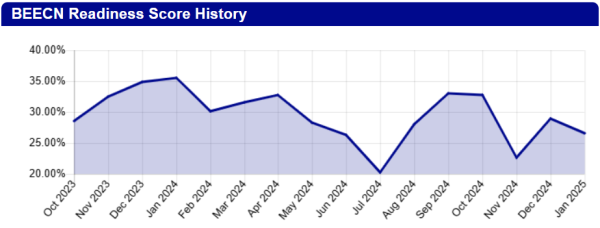
| BEECN Readiness Scores | |
| 2024 Start | January 1, 2024
35.52% |
| 2024 Midyear | July 2, 2024
20.30% |
| 2024 Maximum | January 10, 2024
37.89% |
| 2024 End | December 31, 2024
26.56% |
| Fire stations with no AROs assigned will not be able to activate or relay the messages transmitted by their assigned BEECNs. Having two AROs assigned is optimal; one is risky. |
2024 Volunteer Hours by District
| District
Population |
Volunteers | Hours | Logged % | Pareto | MSC [9] | |||||||||||||
|---|---|---|---|---|---|---|---|---|---|---|---|---|---|---|---|---|---|
| Q1 | Q2 | Q3 | Q4 | Q1 | Q2 | Q3 | Q4 | TOTAL | Q1 | Q2 | Q3 | Q4 | Yearlong | ||||
 |
District 1 | 148,117 [10] | 86 | 90 | 89 | 94 | 395 | 639 | 310 | 378 | 1,722 | 38.4% | 14.0% | 34.4% | 13.3% | 25.8% | 9.0% | 30.9% | 14.0% | 47.8% | 22.3% | 37.2% |
 |
District 2 | 143,013 [11] | 435 | 459 | 457 | 469 | 1,242 | 2,210 | 962 | 1,390 | 5,805 | 25.5% | 9.2% | 26.8% | 11.8% | 20.4% | 6.6% | 24.3% | 9.2% | 39.2% | 16.8% | 28.1% |
 |
District 3 | 153,705 [12] | 355 | 369 | 368 | 383 | 1,331 | 1,819 | 1,184 | 1,796 | 6,131 | 34.4% | 11.0% | 35.0% | 13.6% | 22.3% | 4.3% | 30.5% | 12.5% | 47.5% | 19.3% | 35.5% |
 |
District 4 | 139,967 [13] | 480 | 493 | 490 | 504 | 2,540 | 2,906 | 1,796 | 3,304 | 10,545 | 42.1% | 15.6% | 37.1% | 12.6% | 27.6% | 9.4% | 36.7% | 11.5% | 52.4% | 21.4% | 40.9% |
2024 Hours by Neighborhood
Data definitions/parameters: A "volunteer" on these tables is an Active NET, BEECN, or ATV. Hour quantities are rounded. The number of volunteers is the number listed active in that dataset at the end of the year, while hours are accumulated over the course of a calendar year.
Possible data discrepancies: Some Portland neighborhoods are divided between districts (Brooklyn for example, occupying districts 3 and 4). In the tables below, all neighborhoods are grouped once under a single district. Therefore, totals here may be slightly different than what is found in 2024 Volunteer Hours by District. Volunteers trend towards under-reporting their volunteer hours.
2024 Volunteer Demographics
The data in this section reflects volunteer demographics at the end of the calendar year. The dataset includes all Active volunteers (NET, BEECN, and ATV) who provide demographic information in their profile; individuals will sometimes give only some or none of their demographic information.
2024 Volunteer Age
On average, a volunteer in a PBEM program is 55 years old. But, by a slim margin, the most common age range is 40 to 49.
| Age Group | # | % |
|---|---|---|
| 16 - 19 | 10 | .6% |
| 20 - 29 | 57 | 3.3% |
| 30 - 39 | 239 | 13.8% |
| 40 - 49 | 362 | 20.8% |
| 50 - 59 | 357 | 20.5% |
| 60 - 69 | 337 | 19.4% |
| 70 - 79 | 303 | 17.4% |
| 80 - 89 | 71 | 4.1% |
| 90 - 99 | 2 | .1% |
| DATASET TOTAL | 1,738 | |
2024 Volunteer Race/Ethnicity
13.2% of PBEM volunteers who provide personal information on race/ethnicity identify as other than White.
| Race/Ethnicity | # | % |
|---|---|---|
| American Indian, Alaska Native, or Indigenous Peoples of the Americas | 9 | 0.6% |
| Asian | 24 | 1.7% |
| Black or African American | 19 | 1.3% |
| Latino/a/e/x or Hispanic | 57 | 4.0% |
| Middle Eastern or North African | 2 | 0.1% |
| Native Hawaiian or Pacific Islander | 4 | 0.3% |
| Two or more races | 71 | 5.0% |
| White | 1,228 | 86.8% |
| DATASET TOTAL | 1,414 | |
2024 Volunteer Gender Identification
| Gender Identification | # | % |
|---|---|---|
| Female | 731 | 52.4% |
| Male | 631 | 45.3% |
| Nonbinary | 18 | 1.3% |
| Not listed | 4 | 0.3% |
| Questioning | 2 | 0.1% |
| Trans | 8 | 0.6% |
| DATASET TOTAL | 1,394 | |
2024 Volunteers With Disabilities
Data definitions/parameters: Data about disability status is not collected in individual profiles for confidentiality reasons. Instead, this data is collected anonymously in the annual PBEM volunteer customer service survey. The annual survey collects a scientifically representative sample of the volunteer population, but the dataset is smaller in size than the entire volunteer group. "Disability" is defined by the survey respondents, not by PBEM.
| Disability | # | % |
|---|---|---|
| Physical disability | 17 | 4.9% |
| Cognitive disability | 16 | 4.6% |
| Both physical and cognitive | 6 | 1.7% |
| Neither | 311 | 88.9% |
| DATASET TOTAL | 350 | |
2024 Photo Gallery
-
Portland City Council celebrates NET's 30 Year Anniversary.
-
PBEM's Jeremy and Glenn receiving recognition plaques during Friends of Portland NET's 30 year NET Anniversary party on June 1. Photo by Katy Wolf.
-
NET volunteering at Grand Floral Parade first aid station on June 8. Photo by Roger Wirt.
-
Centennial NET conducting an operations exercise on July 27. Photo by Karen Wolfgang.
-
NETs and CERTs practicing survivor carries at NETCamp. Photo by Lisa Jamieson.
-
Ashcreek NET participating in the Citywide Deployment Exercise on October 30.
-
NET Unidos Contra Desastres at Scenario Village on November 30. Photo by Marisol Lozano-Peralta.
-
Woodstock NET practices with fire extinguishers on December 2. Photo by Mark Ginsberg.
-
Christine Wilson inspecting a BEECN cache.
How to Read the Statistics
This section guides readers on how to read and interpret the numbers that are not straightforward.
Logged %
Indicates the percentage of volunteers in the subject dataset that logged any hours at all (x > 0).
Pareto Numbers
Pareto Numbers are based on the Pareto Principle; the notion that for many outcomes, roughly 80% of consequences come from 20% of causes. For volunteer purposes, it is an index of volunteer activity. In strict mathematical terms, the Pareto Number indicates what percentage of active volunteers are logging 80% of the volunteer hours. If your NET community is a beehive, the Pareto Number answers: how loudly is that beehive buzzing?
The number indexes volunteer community activity in the respect that a low number would indicate very few active volunteers are actually engaged with programming. This would imply several prospective problems in that volunteer community, not the least of which include:
- Low volunteer activity;
- A small "hard core" of volunteers burning themselves out carrying the activity and volunteer labor of the other volunteers;
- A volunteer roster populated with inactive volunteers;
- A volunteer community where few of the volunteers know each other or regularly work together (particularly troublesome for disaster response volunteers).
Example: A Tale of Two Teams
Let's say there are two teams: Team 1 and Team 2. Each has ten volunteers. In a year, Team 1 logged 105 hours and Team 2 logged 100 hours. On the face of it, those numbers might suggest Team 1 was slightly more active than Team 2 in that year. But if we pull the hours of each individual team member, the picture looks like this:
| Team 1 | Team 2 | ||
|---|---|---|---|
| Volunteer | Hours | Volunteer | Hours |
| Vol. 1a | 85 | Vol. 2a | 20 |
| Vol. 1b | 6 | Vol. 2b | 17 |
| Vol. 1c | 5 | Vol. 2c | 15 |
| Vol. 1d | 3 | Vol. 2d | 15 |
| Vol. 1e | 3 | Vol. 2e | 12 |
| Vol. 1f | 0 | Vol. 2f | 11 |
| Vol. 1g | 0 | Vol. 2g | 7 |
| Vol. 1h | 0 | Vol. 2h | 3 |
| Vol. 1i | 0 | Vol. 2i | 0 |
| Vol. 1j | 0 | Vol. 2j | 0 |
80% of each team's hours is 84 and 80, respectively. On Team 1, one volunteer accomplished that portion. On Team 2, five volunteers made up 80% of the hours. So in this example, Team 1 has a Pareto score of 10% and Team 2 has 50%. Even though Team 1 logged more hours, Team 2 is distributing more of the weight of the work amongst themselves. This could mean that Team 2 is more resilient to volunteer burnout and has denser collaborative relationships.
This is not to denigrate the effort of "super volunteer" on Team 1 (who is also probably the Team Leader). We love super volunteers and appreciate their work! But if we need to evaluate the health of a team, we would encourage that volunteer to ask their teammates for help, or plan with PBEM how to get those volunteers more involved. A small number of volunteers should not be asked to carry the resilience effort of a whole neighborhood; that is simply too much. There are also five volunteers on Team 1 who logged zero hours. The Team Leader may want to ask PBEM if those volunteers are still active in the program.
Yearlong vs. Quarterly Pareto Numbers
This Wiki article references both annual ("Yearlong") and quarterly Pareto Numbers for Portland Districts. However, only the annual number is really important; quarterly figures are more of a curiosity and do not really say much about overall team activity.
MSC: Minimum Service Contribution
This metric indicates what percentage of active volunteers in the dataset made their Minimum Service Contribution of twelve logged hours in a year.
Notes and References
- ↑ Estimating team hours is tricky, because team members do not spend all their hours on community preparedness programming. The team will get deployed during incidents or work on other bureau projects. Also, some weeks, team members may volunteer time over 40 hours.
- ↑ All hour totals represent the number of hours logged by volunteers. Actual volunteer hours are underreported.
- ↑ Deployment hours represent hours spent responding to an emergency incident. Service hours represent hours that directly improve programming, such as through instruction, event planning, filming training videos, writing articles, and so on.
- ↑ Hours spent either in Basic NET Training, or hours refreshing basic volunteer skills (e.g. an Active NET volunteer re-taking Basic NET Training).
- ↑ Hours in advanced training courses or in response exercises.
- ↑ Any hours related to BEECN or amateur radio activities by PBEM volunteers.
- ↑ Community engagement hours include NET team meetings, community presentations, NET Team Leader responsibilities, tabling at events, etc.
- ↑ The "Pareto number" (based on the Pareto Principle) is an index of volunteer activity. It is one method for measuring how active PBEM volunteers are. The number is the percentage of active PBEM volunteers who contributed 80% of the reported volunteer hours. A higher number is a higher representation of activity (so: the higher the number, the better). A program with consistently low Pareto numbers is probably not sustainable, as that would indicate a very small number of volunteers doing almost all of the work.
- ↑ Minimum Service Contribution.
- ↑ From: https://www.portland.gov/civic/documents/district-1-profile-2023/download
- ↑ From: https://www.portland.gov/civic/documents/district-2-profile-2023/download
- ↑ From: https://www.portland.gov/civic/documents/district-3-profile-2023/download
- ↑ From: https://www.portland.gov/civic/documents/district-4-profile-2023/download




